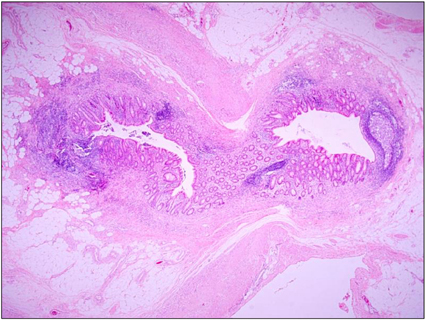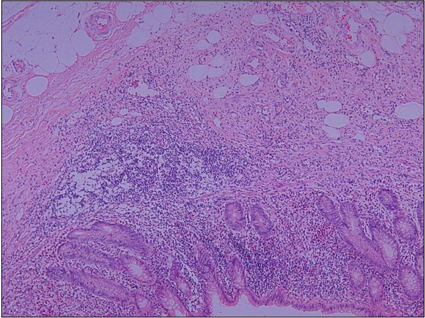J Korean Surg Soc.
2013 Jan;84(1):33-37.
Clinical characteristics of acute appendiceal diverticulitis
- Affiliations
-
- 1Department of Surgery, Eulji University College of Medicine, Seoul, Korea. cutdown@eulji.ac.kr
- 2Department of Internal Medicine, Eulji University College of Medicine, Seoul, Korea.
- 3Department of Pathology, Eulji University College of Medicine, Seoul, Korea.
Abstract
- PURPOSE
Diverticulitis of vermiform appendix is known as a rare cause of acute appendicitis, most of which are diagnosed after surgery. We compared appendiceal diverticulitis with acute appendicitis to study the clinical characteristics of appendiceal diverticulitis.
METHODS
Among 1,029 patients who received appendectomy from January 2009 to May 2011, 38 patients with appendiceal diverticulitis (diverticulitis group) were compared with 98 randomly collected patients with acute appendicitis (appendicitis group) during the same period. Patients' characteristics, clinical features, laboratory findings, operative findings, and postoperative course were compared between the two groups.
RESULTS
Thirty-eight patients (3.7%) were pathologically diagnosed with acute appendiceal diverticulitis among 1,029 cases of appendectomy. The mean age of patients in the diverticulitis group was significantly older than that of the appendicitis group (49.0 +/- 15.2 years vs. 25.4 +/- 14.2 years, P < 0.05). Mean duration of preoperative symptoms was longer in the diverticulitis group (3.6 +/- 3.8 days vs. 1.8 +/- 3.2 days, P < 0.05). The site of abdominal pain, fever, signs of localized peritonitis, accompanying gastrointestinal symptoms, and white blood cell count showed no differences between the two groups. Twenty-five patients (65.8%) of the diverticulitis group and 10 patients (10.2%) of the appendicitis group showed perforation of appendix (P < 0.05). Mean operating time and postoperative hospital stay were longer in the diverticulitis group (55.3 +/- 28.8 minutes vs. 41.4 +/- 17.8 minutes, 6.8 +/- 3.4 days vs. 4.9 +/- 1.5 days, P < 0.05).
CONCLUSION
Acute diverticulitis of the appendix can be classified into quite different disease entities compared with acute appendicitis. Regarding high rates of perforation, immediate surgical treatment is needed for patients with a high index of suspicion of acute diverticulitis of the appendix.
MeSH Terms
Figure
Reference
-
1. Abdullgaffar B. Diverticulosis and diverticulitis of the appendix. Int J Surg Pathol. 2009. 17:231–237.2. Heffernan DS, Saqib N, Terry M. A case of appendiceal diverticulitis, and a review of the literature. Ir J Med Sci. 2009. 178:519–521.3. Kabiri H, Clarke LE, Tzarnas CD. Appendiceal diverticulitis. Am Surg. 2006. 72:221–223.4. Simpson J, Lobo DN, Spiller RC, Scholefield JH. Diverticular abscess of the appendix: report of a case and review of the literature. Dis Colon Rectum. 2003. 46:832–834.5. Collins DC. A study of 50,000 specimens of the human vermiform appendix. Surg Gynecol Obstet. 1955. 101:437–445.6. Yamana I, Kawamoto S, Inada K, Nagao S, Yoshida T, Yamashita Y. Clinical characteristics of 12 cases of appendiceal diverticulitis: a comparison with 378 cases of acute appendicitis. Surg Today. 2012. 42:363–367.7. Buffo GC, Clair MR, Bonheim P. Diverticulosis of the vermiform appendix. Gastrointest Radiol. 1986. 11:108–109.8. Fitzer PM, Rao KG, Bundrick TJ. Diverticulosis of the appendix: radiographic and clinical features. South Med J. 1985. 78:1512–1514.9. Lipton S, Estrin J, Glasser I. Diverticular disease of the appendix. Surg Gynecol Obstet. 1989. 168:13–16.10. Shin IY, Ahn CJ, Cheon JS, Kim JG, Lee DH, You YK, et al. Diverticula of appendix associated with chronic abdominal pain: a case report. J Korean Soc Coloproctol. 2006. 22:58–61.11. Favara BE. Multiple congenital diverticula of the vermiform appendix. Am J Clin Pathol. 1968. 49:60–64.12. Phillips BJ, Perry CW. Appendiceal diverticulitis. Mayo Clin Proc. 1999. 74:890–892.13. Kubota T, Omori T, Yamamoto J, Nagai M, Tamaki S, Sasaki K. Sonographic findings of acute appendiceal diverticulitis. World J Gastroenterol. 2006. 12:4104–4105.14. Osada H, Ohno H, Saiga K, Watanabe W, Okada T, Honda N. Appendiceal diverticulitis: multidetector CT features. Jpn J Radiol. 2012. 30:242–248.15. Choi SI, Shin JK, Lee SH, Kim DS, Lee DH, Kang YS. A case of hemorrhage from a diverticulum of the appendix. J Korean Soc Coloproctol. 2005. 21:48–51.16. Lee YS, Lee IK, Kim JJ, Lee KH, Oh SJ, Park SM, et al. Intussusception combined with appendiceal diverticulosis in adult. J Korean Surg Soc. 2007. 72:319–322.17. Lamps LW, Gray GF Jr, Dilday BR, Washington MK. The coexistence of low-grade mucinous neoplasms of the appendix and appendiceal diverticula: a possible role in the pathogenesis of pseudomyxoma peritonei. Mod Pathol. 2000. 13:495–501.



